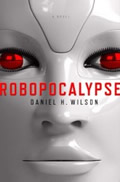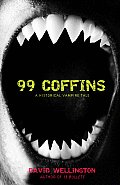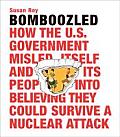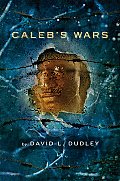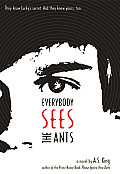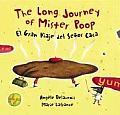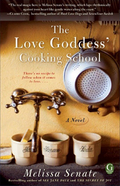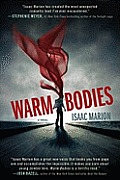Link to this review in the form of a comic strip by geneambaum tagged science fiction
Link to this review by geneambaum tagged thriller • horror
An archaeological dig in Gettysburg uncovers a cavern filled with coffins. Ninety-nine contain vampire skeletons dating from the Civil War era. The hundredth has been smashed to pieces.
Jameson Arkeley, crippled by the hunt in 13 Bullets, contacts Pennsylvania State Trooper Laura Caxton for help investigating the scene and making sure the vampires don’t rise from their graves. She’s already suffered enough at the hands of the undead, but he goads her into assisting him.
Why I picked it up: I needed a fast-paced book filled with well-written, grisly violence. I blame it on all the Undead Nightmare I’ve been playing lately. Plus this is the only book in the series I hadn’t read.
Why I finished it: With the possibility of ninety-nine vampires rising from their graves, I knew Wellington wouldn’t leave the undead population of Gettysburg at one. Wellington’s vampires are quick, gruesome, pale (but not sparkly) creatures, the prose equivalent of Ben Templesmith’s illustrations in 30 Days of Night. Plus I had to keep reading the Civil War soldiers’ journal entries, which alternated with the contemporary story’s chapters, to find out the shameful truth about why the well-preserved vampire graveyard was created.
I’d give it to: Talia, who has a taste for gore. These vampires are immortal, but as they age, they need more and more blood each night to thrive, which makes for some scenes she’ll love.
Link to this review by sarahhunt tagged history • science
After the devastation of the atomic bomb in Japan, the Soviets developed their own bomb a few years later. Americans were terrified by the possible destruction of their homes and lives. The US government responded with a Civil Defense plan which made the building and equipping of bomb shelters a family responsibility.
Roy includes the publications of various Civil Defense organizations, articles about nuclear preparedness, and pictures of actual shelters, from huge and glamorous to tiny and awful. She even delves into the university-developed plan behind the shelter program, which was intended to reduce fear rather than save lives.
Why I picked it up: I had wondered how people reacted to having the responsibility for protecting their own children. Did they really cheerfully dig up their yards and basements?
Why I finished it: The answer was mostly no. Also, I hadn’t previously noticed the change from encouraging the construction of bomb shelters to encouraging fallout shelters. This was after the development of more powerful bombs which would only be survivable for those far enough away from the ground zero. (They only needed to protect themselves from fallout.) Concrete industry groups were enthusiastic, but most people weren’t as gung-ho about post-apocalypse living.
I’d give it to: Gene, for the hair-raising story of the couple who spent three days in their fallout shelter as part of a publicity stunt. They had a toilet in their shelter (often left out of promotional models), but later admitted they filled it up on the second day, forcing them to use any other container they could find!
Link to this review by flemtastic tagged historical fiction
Caleb, a young boy who has just been baptized, is struggling with his treatment at the hands of white folks in his small town. He is also clashing repeatedly with his domineering father, adjusting to his brother heading off to fight the Nazis, and deciding whether to believe that he can hear God’s voice speaking to him. When Caleb accepts a job working at the new diner, he finds himself working with a German POW brought there to provide labor. Caleb must decide what kind of man he is and the sort of treatment he’ll endure before fighting back.
Why I picked it up: I have not read a historical civil rights novel in a while, and this one promised a new complication, German POWs.
Why I finished it: Watching Caleb deal with everyday slights, like having to apologize to a white woman for her misbehavior and seeing a loved one lose her job, was agonizing. I found myself talking out loud to the book in my frustration. It doesn’t offer simplistic resolutions, but it does give a real sense of the racism of the time.
I’d give it to: History teachers at my school would be interested in sharing this with students because of its depiction of life for African Americans in the Jim Crow South. For example, Caleb has to step into the mud beside the sidewalk, ruining his good shoes, because a white woman and her daughter are passing by. Dick, who enjoys documentaries about WWII, but who is probably unaware (as I was) that hundreds of thousands of German POWs spent time in POW camps in the U.S.
Link to this review by flemtastic tagged coming of age
Lucky Linderman proposes graphing and calculating how his fellow students would kill themselves for his freshman project. He gets therapy sessions for the rest of the school year and a set of concerned parents. Lucky has been bullied by Nader McMillan for years and has tried to get away from him without success. After a run-in with Nader that results in a facial scar, his mom takes him to Uncle Dave’s and Aunt Jodi’s house in Arizona. It is a good trip for Lucky, despite the fact Uncle Dave is a womanizer and Aunt Jodi needs the therapy more than he does. He does get to meet Ginny, a beautiful and rebellious hair model on shampoo billboards all around town. But his nightmares about trying to save his POW/MIA grandfather from a jungle prison have followed him from Pennsylvania. And he still sees the sarcastic, cartoonish ants that line up to spell out letters in both his dreams and real life.
Why I picked it up: A.S. King made a wooden pagoda a character in Please Ignore Vera Dietz. Anyone that can make that work deserves to have her books read.
Why I finished it: Lucky is a thoughtful, wryly funny kid. As his scar heals, he traces its shape from Ohio to Michigan and finally to Hawaii. Lucky lacks experience with girls but then finds himself in a car with five girls on their way to rehearse The Vagina Monologues. They chant “Vagina” at the top of their lungs while he fights an erection.
I’d give it to: Kayla, because she would love Lucky’s outward obedience and inner irreverence towards things he finds ridiculous, like Aunt Jodi’s feng shui obsession (even while folding laundry). And Mike, because this style of deadpan humor, as well as the morbid subject matter, would appeal to his darker side.
Link to this review by geneambaum tagged picture book • science
A wolf in a lab coat gives a young girl a delicious apple and then accompanies it all the way through her digestive tract.
A bilingual book with text in both Spanish and English, including the sound effects and labels on the map of the digestive system.
Why I picked it up: @jen_young told me about it after I referred anyone who was confused about Cathy’s pregnancy to my favorite kids book on the subject.
Why I finished it: I don’t speak Spanish, but even I know who “Señor Caca” is, plus on the cover he’s carrying a briefcase and wearing a hat like he’s on his way to work. I also love the wolf, who seems a bit crazy (but informative) as he stirs up the gut with a giant spoon, snorkels in the mush and then phones the liver for help.
I’d give it to: My friend Shannon, the cheeriest librarian I know, who collects poop books (like me!) and toilet paper from around the world.
Link to this review by vanessaborden tagged coming of age • cookbook
After two years, the man Holly Maguire moved cross country for fell in love with someone else. Holly Maguire has been dumped again. She moves into her grandmother Camilla’s house to recover and figure out what she is meant to do. Camilla, known locally as the Love Goddess, tells fortunes, runs Camilla’s Cucinotta, and teaches cooking classes. When Camilla dies, Holly is forced to face her fears and ineptness in the kitchen to make sure that her grandmother’s legacy lives on. Gradually, Holly sheds her fears of cooking and, with the help of her four cooking students, begins to discover what she is supposed to do.
Why I picked it up: I recently reread Senate’s See Jane Date. I also love books. And food. So I love books about food. No-brainer.
Why I finished it: I loved watching Holly grow from being fear-ridden and desperate to confident. After a few weeks of selling her own mediocre pasta, Holly is offered the chance to cater a wedding. For the first time, Holly eagerly tries a new recipe and finds the results reflect her passion.
I’d give it to: My mom, because Camilla’s recipes always call for a special ingredient — sometimes it is a wish and other times it is a memory. I loved how Camilla made cooking a way to express hopes, acknowledge grief, and express gratitude. I hope my mom reads this and knows that every time I make pasta margherita, the happy memory that goes in is of the many times we’ve cooked the same dish together and the joy she brings to my life.
Link to this review by billba tagged humor • comic strips
Extensively annotated collection of comics that heavily reference pop culture, with a special emphasis on The Works of Joss Whedon, Apple Products, and Bacon.
Why I picked it up: I wrote an incredibly mean (the truth hurts) foreword to the first volume, and I wanted to see if Eureka writer Amy Berg carried on the tradition. She didn’t.
Why I finished it: Comic annotations are one of those things it’s easy to get wrong, but Joel gets them right. They are often funnier than the comics themselves. And if you were in a coma for the last few years you could do worse in terms of catching up on important world events.
I’d give it to: Paul, who shares with Joel an extensive, nay, comprehensive knowledge of 80’s TV and movies that far exceeds my own even though they were, at that point, either infants or not even born.
Link to this review by dawnrutherford tagged horror • romance
R can’t remember how long he has been a zombie or who he was before that. Life is an endless cycle of eating, moaning, and riding the escalators at the airport his hive has infested. But then he eats a teenaged guy’s brain, flooding him with memories and thoughts that compel him to protect a girl named Julie. His unlife will never be the same again.
Why I picked it up: How could a zombie romance be a satisfying read? I was curious when I saw this in EW, in a list of books being made into movies. Then I saw that Audrey Niffenegger (The Time Traveler’s Wife) had blurbed it, and I decided to give it a chance.
Why I finished it: After I accepted the idea of a person with feelings trapped in the head of this lifeless body, making him an effective narrator, I loved the details about zombie society, communication, and evolution. I had no trouble buying that a lightly-decayed zombie could charm a living girl by making a home in an airplane, singing Frank Sinatra, and learning how to drive a convertible.
I’d give it to: Erin, who will appreciate the message of love and hope without being too turned off by the gore.
